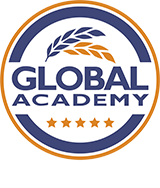ServSafe Int'l Food Safety Training April 2024
Course
This Food Safety Training Course helps you understand all of the food safety risks faced by your operation. Once you are aware of these risks, you can find ways to reduce them. This will help keep your operation, your staff, and your customers safe. The topics you will learn in this program were determined by those who deal with the same food safety issues you face every day. From the basics of handwashing, to more complex topics such as foodborne pathogens, your industry peers have provided you with the building blocks to keep food safe throughout your operation.
At the end of the course, you will take your ServSafe Food Protection Manager Certification Exam in person. This certification is valid for five years from your exam date.
This Food Safety Training helps you understand all of the food safety risks faced by your operation. Once you are aware of these risks, you can find ways to reduce them. This will help keep your operation, your staff, and your customers safe. The topics you will learn in this program were determined by those who deal with the same food safety issues you face every day. From the basics of handwashing, to more complex topics such as foodborne pathogens, your industry peers have provided you with the building blocks to keep food safe throughout your operation.
At the end of the course, you will take your ServSafe Food Safety Certification Exam in person. This certification is valid for five years from your exam date.
The training program consists of the following modules:
Module 1: Providing Safe Food
- Foodborne Illnesses
- How Foodborne Illnesses Occur
- Keeping Food Safe
Module 2: Forms of Contamination
- Biological, Chemical, and Physical Contaminants
- Deliberate Contamination of Food
- Responding to a Foodborne-Illness Outbreak
- Food Allergens
Module 3: The Safe Food Handler
- How Food Handlers Can Contaminate Food
- Handwashing and Hand Care
- Single use Gloves
- Personal Hygiene Practices
- Policies for Reporting Health Issues
Module 4: The Flow Of Food: An Introduction
- Hazards in the Flow of Food
- Monitoring Time and Temperature
Module 5: The Flow of Food: Purchasing, Receiving, and Storage
- General Purchasing and Receiving Principles
- Storing
Module 6: The Flow of Food: Preparation
- Preparation
- Prepping Specific Food
- Cooking Food
- Cooling and Reheating Food
Chapter 7: The Flow of Food: Service
- Holding Food
- Serving Food
Module 8: Food Safety Management Systems
- Food Safety Management Systems and HACCP
Module 10: Safe Facilities and Pest Management
- Interior Requirements for a Safe Operation
- Emergencies That Affect the Facility
- Pest Management
Module 10: Cleaning and Sanitizing
- Cleaning and Sanitizing
- Dishwashing
- Cleaning and Sanitizing in the Operation
Here is the course outline:
OrientationThe information in this section will help you get started with the course. Please read the contents carefully. 4 sections
|
||||
|
Module 1: Providing Safe FoodPreventing foodborne illnesses is one of your most important tasks as a manager. This chapter will introduce you to the basics of keeping food safe. 6 sections
|
||||||
|
Module 2: Forms of ContaminationIllnesses such can be prevented if you understand how pathogens contaminate food. In this chapter, you will learn about contaminants and contamination of food, foodborne illness outbreaks and how to respond to them, and common food allergens and preventing reactions. 4 sections
|
||||
|
Module 3: The Safe Food HandlerThis chapter will explore health problems that pose a risk to food safety and other requirements for a good personal hygiene program. 10 sections
|
||||||||||
|
Module 4: The Flow of Food: An IntroductionIn this chapter, you will learn some general practices for keeping food safe throughout the flow of food in your operation. You will also learn about some tools to help with this. 5 sections
|
|||||
|
Module 5: The Flow of Food: Purchasing, Receiving, and StorageIn this chapter, you will learn about storage practices that can help prevent food borne illness outbreaks. You will also learn about practices that can be put into place to help ensure the food you receive is safe. 5 sections
|
|||||
|
Module 6: The Flow of Food: PreparationIn this chapter, you will learn about specific cooking temperatures than can keep food safe. You will also learn other guidelines for keeping food safe during preparation. 7 sections
|
|||||||
|
Module 7: The Flow of Food: ServiceIn this chapter, you will learn guidelines for keeping food safe after you have prepped and cooked it. 6 sections
|
||||||
|
Module 8: Food Safety Management SystemsIn this chapter, you will learn how to help prevent foodborne-illnesses and outbreaks by creating and implementing a food safety management system that includes active managerial control. 4 sections
|
||||
|
Module 9: Safe Facilities and Pest ManagementTo make sure your facility is safe for food service, you should keep equipment and the building well maintained. It is also important to prevent the entrance of pests, which you will learn more about in this chapter. 6 sections
|
||||||
|
Module 10: Cleaning and SanitizingCleaning and sanitizing food contact surfaces can help you avoid foodborne-illness outbreaks. This chapter will teach you what you need to know about effective sanitizing methods, proper use of dishwashing equipment, cleaning tools and supplies, and developing a cleaning program. 6 sections
|
||||||
|
Practice TestPrepare for your Certification Exam using this Practice Test 2 sections
|
||
|
In-Person Certification Exam
Apr 30 8:30am .. 12pm, GA Pasig
Take the 80-item certification exam in GA Pasig. 1 section
|
|
|





.png?lmsauth=42d804030756030b4cbe9c20a0cb712755a20da8)